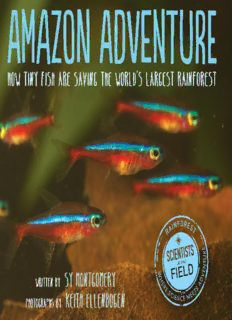
Amazon Adventure: How Tiny Fish Are Saving the World’s Largest Rainforest PDF
Preview Amazon Adventure: How Tiny Fish Are Saving the World’s Largest Rainforest
Contents Title Page Contents Frontispieces Dedication Copyright Map of the Amazon Little Fish, Giant Jungle Kingdom of the Cardinals Scott’s Story Barcelos Festival of the Fish From Fish Morgue to Fish Spa Daracua Selected Bibliography Web Resources Acknowledgments Index About the Author and Photographer Connect with HMH on Social Media FOR DR. MILLMOSS, IN MEMORY OF SALLY —S.M. TO MY NIECE, MAYA, WHOSE LOVE OF NATURE IS BOUNDLESS —K.E. Text copyright © 2017 by Sy Montgomery Photographs copyright © 2017 by Keith Ellenbogen except on pages 16 and 17, which are © Charles Doughty Map and fish spot illustrations © Sarah Green All rights reserved. For information about permission to reproduce selections from this book, write to [email protected] or to Permissions, Houghton Mifflin Harcourt Publishing Company, 3 Park Avenue, 19th Floor, New York, New York 10016. www.hmhco.com Library of Congress Cataloging-in-Publication Data is on file. ISBN 978-0-544-35299-5 eISBN 978-1-328-69498-0 v1.0617 CHAPTER 1 LITTLE FISH, GIANT JUNGLE The crowns of drowned trees form islands along the river margins. It’s the planet’s richest ecosystem, where a butterfly’s wing can grow as big as your hand and five hundred species, from frogs to insects, can be found on a single flower. The Amazon basin—the 2,670,000 square miles drained by the Amazon River and its many tributaries—is the world’s largest jungle, an area as big as the lower forty-eight U.S. states, the same size of the face of the full moon. Jaguars hunt in the shade of two-hundred-foot-tall trees; pink dolphins, who the local people claim have magic powers, swim in the rivers. New species discovered here in the last decade include a tarantula striped like a tiger, a bald parrot, a vegetarian piranha, and a monkey who purrs like a kitten. The MV Iracema, one of two riverboats carrying the Project Piaba team on its adventure. This huge, ancient rainforest is essential to the planet. Because its trees provide a full fifth of the world’s oxygen, it’s considered “the lungs of the world.” Yet it all could vanish—and soon. Each year, mining, clear-cutting, burning, and cattle ranching destroy an area of Amazon forest twice the size of the city of Los Angeles. Luckily, beneath the glassy surface of its rivers live dozens of species of tiny, beautiful fish whose powers may be even greater than those of the mysterious pink dolphin or the mighty jaguar. These shy fish—so small the locals call them all piaba (pee-AH-bah), which roughly translates to “small fry” or “pip- squeak”—just might be able to save the Amazon. How? We’re on our way to find out. We’re traveling by riverboat from the port of Manaus up Brazil’s Río Negro, one of the two main arteries that join to form the Amazon River. Our destination, 307 miles to the north, is Barcelos, a town of twenty-five thousand. Each year, fishermen come here from miles around, bringing some forty million of these small, colorful tropical fish that they caught in their forest communities. From Barcelos, the fish will be shipped to Manaus, and from there to public and home aquarium tanks around the world.
Description: